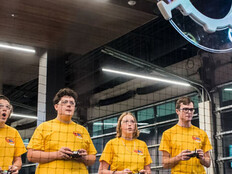ISTE 2013: 5 Takeaways from Jane McGonigal’s Opening Keynote
More than 18,000 educators, IT leaders, vendors and educational technology enthusiasts have gathered in San Antonio this week for the International Society for Technology in Education’s 34th annual conference and exposition.
The event formally kicked off Sunday night, June 23, with a big rebranding announcement from ISTE and an energetic keynote address from Jane McGonigal, author of Reality Is Broken: Why Games Make Us Better and How They Can Change the World and an adviser and affiliate researcher with the Institute for the Future, which strives to “provide practical foresight for a world undergoing rapid change.”
As ISTE President Dr. Kecia Ray explained in her introduction, McGonigal believes “that games can change the world and that game designers are happiness engineers — experts in making difficult tasks engaging.” McGonigal’s specialty, Ray continued, “is alternate reality games that challenge players to tackle real-world problems such as climate change and poverty.”
McGonigal’s remarks included a bevy of interesting facts about gaming, as well as a group play exercise — what she called “massively multiplayer thumb wrestling” — and peeks at two of her recent alternate reality games: EVOKE (2010), a “crash course in changing the world”; and Find the Future (2011), which challenged 500 student authors to write a book in one night while inside the New York Public Library.
Here are five key things McGonigal wanted ISTE 2013 attendees to know about gaming and education:
1. There Are Now 1 Billion Gamers Worldwide
According to McGonigal, this “critical milestone,” recently reached, encompasses everyone who spends at least one hour a day playing a game on a connected device — be it a gaming console, a smartphone, a tablet or a computer. “When you add it all up,” she said, “that’s seven billion-plus hours a week spent in maximum engagement through games.”
2. The Longer Students Stay in School, the Less Engaged They Become
McGonigal explained to attendees that 76 percent of elementary school students are engaged in learning. That number drops to 61 percent for middle schools and just 44 percent for high school students.
3. In Gaming, There’s Not Much of a Gender Gap
In the United States, 99 percent of boys under the age of 18 play video games regularly, spending about 13 hours a week engaged in such activity. By comparison, 94 percent of all girls in that same age group spend about eight hours a week playing games. Remarkably, she added, 92 percent of 2-year-olds are already playing video games.
4. Gamers Seek 10 Positive Emotions from Gaming Experiences
“The desire to feel creative drives a lot of game play,” McGonigal said, “but gamers also want to feel — in this order — contentment, awe and wonder, excitement, curiosity, pride, surprise, love, relief and joy.”
5. McGonigal Considers Gamers “Super-Empowered Hopeful Individuals”
As she told attendees, “If you can experience three positive emotions for every one negative emotion, you dramatically improve your odds of success in every area of your life.”
So, how do educators connect the 1 billion gamers in the world with learning? McGonigal told attendees they can do it by “empowering students to make contributions to the world now, while they’re still in school.”
Learn more about McGonigal at janemcgonigal.com and follow her on Twitter at @avantgame. For more updates from ISTE 2013, follow our ISTE 2013 conference hub for articles, videos and more.








